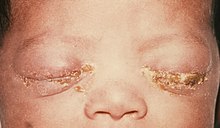Ophthalmia neonatorum
| Classification according to ICD-10 | |
|---|---|
| P39.1 | Neonatal conjunctivitis |
| A54.3 | Gonococcal infection of the eye |
| ICD-10 online (WHO version 2019) | |
The ophthalmia neonatorum or Neugeborenenkonjunktivitis is an infectious conjunctivitis (conjunctivitis) of the eyes of newborns in the first weeks of life caused by different pollutants ( toxicants can be triggered). The incubation period for infectious conjunctivitis is between 2 and 14 days. Infestation on both sides is the rule.
causes
The classic trigger of ophthalmia neonatorum are gonococci . Since there has been a drastic decline in gonorrhea in the last few decades, other pathogens are in the foreground. This includes chlamydia , which cause up to 73% of cases. Herpes viruses , streptococci , staphylococci or pseudomonads can also be responsible for conjunctivitis. One of the non-infectious causes is chemical conjunctivitis after the use of silver nitrate for Credé prophylaxis .
For all forms, a differential diagnostic examination using secretion swabs and microbial cultures as well as an assessment of the time at which the disease occurs is indicated.
| Pathogen / trigger | First symptoms appear |
|---|---|
| Credé prophylaxis | after a few hours |
| Gonococci | on the 1st to 3rd day of life |
| Streptococci, staphylococci or pseudomonads | on the 4th to 5th day of life |
| Herpes simplex viruses | on the 5th to 7th day of life |
| Chlamydia | on the 5th to 14th day of life |
Gonoblennorrhea
The Gonoblennorrhoe (also Gonoblennorrhö, gonococcal conjunctivitis) is a purulent conjunctivitis ( Ophthalmoblennorrhoe ) in newborns with an incubation time of about 48 to 72 hours. It is caused by a bacterial infection with Neisseria gonorrhoeae as a complication of gonorrhea ("gonorrhea"). The massive accumulations of pus under the glued eyelids are typical , which can lead to splashing out when the eyes are opened under pressure and to infection of the examiner himself. It is therefore advisable to wear protective goggles during the examination. The disease can lead to blindness. It is often accompanied by an infection with chlamydia . Infection can occur both in newborns through transmission from the sick mother during birth and in adults (usually through smear infection). Too late or inadequate treatment quickly leads to a corneal ulcer and its perforation.
An outbreak of gonoblennorrhea in newborns is attempted with the help of Credé prophylaxis . It is still strongly recommended today as a measure because of its high effectiveness against gonococci. A combined administration with erythromycin , which is particularly effective against chlamydia, is also used. If the prophylaxis is rejected by the parents, doctors make do with alternatives such as antiseptics (mainly povidone-iodine ) or antibiotics .
swell
- Hoffmann-La Roche AG, Urban & Schwarzenberg (Ed.): Roche Lexicon Medicine. 4th edition. Urban & Schwarzenberg 1998, ISBN 3-541-17114-6 .
- U. Schaller et al.: Ophthalmia neonatorum through Chlamydia trachomatis rapid diagnosis and therapy. . In: The ophthalmologist. Springer Medizin Verlag, 1997, Volume 94, Issue 5, pp. 317-320.
- Prophylaxis of ophthalmia neonatorum. on universimed.com, accessed June 8, 2014
Individual evidence
- ↑ Th. Axenfeld (conception), H. Pau (ed.): Textbook and atlas of ophthalmology. With the collaboration of R. Sachsenweger and others Gustav Fischer Verlag, Stuttgart 1980, ISBN 3-437-00255-4 , p. 172 ff.
- ^ A b c Franz Grehn: Ophthalmology. 30th edition. Springer Verlag, Berlin 2012, ISBN 978-3-642-11332-1 , p. 95 ff.
